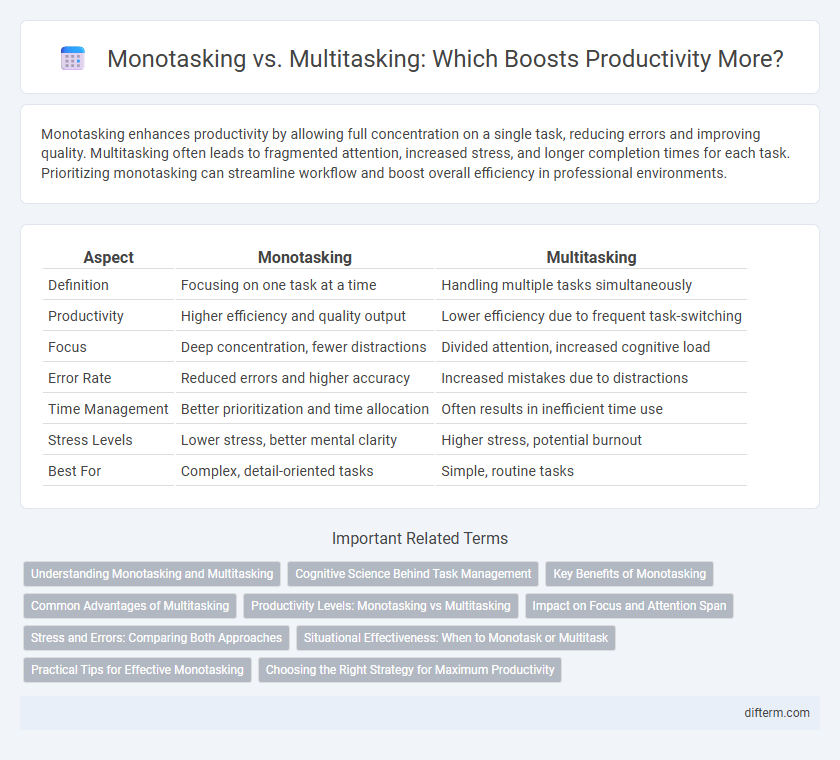Monotasking enhances productivity by allowing full concentration on a single task, reducing errors and improving quality. Multitasking often leads to fragmented attention, increased stress, and longer completion times for each task. Prioritizing monotasking can streamline workflow and boost overall efficiency in professional environments.
Table of Comparison
| Aspect | Monotasking | Multitasking |
|---|---|---|
| Definition | Focusing on one task at a time | Handling multiple tasks simultaneously |
| Productivity | Higher efficiency and quality output | Lower efficiency due to frequent task-switching |
| Focus | Deep concentration, fewer distractions | Divided attention, increased cognitive load |
| Error Rate | Reduced errors and higher accuracy | Increased mistakes due to distractions |
| Time Management | Better prioritization and time allocation | Often results in inefficient time use |
| Stress Levels | Lower stress, better mental clarity | Higher stress, potential burnout |
| Best For | Complex, detail-oriented tasks | Simple, routine tasks |
Understanding Monotasking and Multitasking
Monotasking involves focusing on a single task at a time, which enhances concentration and reduces cognitive overload. Multitasking requires juggling multiple tasks simultaneously, often leading to decreased efficiency and increased errors due to divided attention. Research shows that monotasking significantly improves productivity by enabling deeper engagement and faster completion of complex tasks.
Cognitive Science Behind Task Management
Cognitive science reveals that monotasking enhances working memory capacity and reduces cognitive load, enabling deeper focus and higher-quality output. Multitasking divides attention across multiple tasks, increasing task-switching costs and mental fatigue, which often leads to decreased productivity and more errors. Brain imaging studies confirm that the prefrontal cortex operates more efficiently during sustained attention on a single task, highlighting monotasking as a superior strategy for cognitive performance and task management.
Key Benefits of Monotasking
Monotasking boosts productivity by enabling deeper focus, reducing cognitive overload, and minimizing errors compared to multitasking. Research shows monotasking increases task completion speed by 25% and improves memory retention by up to 50%. This method enhances overall work quality and decreases stress levels, supporting sustained efficiency.
Common Advantages of Multitasking
Multitasking enhances productivity by allowing individuals to handle multiple tasks simultaneously, increasing efficiency in time-sensitive environments. It improves cognitive flexibility as the brain switches between different activities, fostering adaptability and problem-solving skills. Multitasking also supports effective time management by enabling parallel progress on diverse projects or responsibilities.
Productivity Levels: Monotasking vs Multitasking
Monotasking significantly enhances productivity levels by allowing focused attention on a single task, reducing cognitive load and minimizing errors. In contrast, multitasking often leads to fragmented focus, increased mental fatigue, and lower overall efficiency, as the brain switches between tasks rather than processing simultaneously. Studies reveal that monotasking can improve task completion time by up to 40% compared to multitasking, highlighting its superiority in optimizing productivity.
Impact on Focus and Attention Span
Monotasking enhances focus and extends attention span by allowing the brain to concentrate on a single task, reducing cognitive overload. Multitasking divides attention across multiple activities, leading to fragmented focus and increased errors. Studies show that monotasking improves productivity and information retention more effectively than multitasking.
Stress and Errors: Comparing Both Approaches
Monotasking reduces cognitive load, leading to lower stress levels and fewer errors by allowing focused attention on one task at a time. Multitasking increases stress due to constant task-switching, which disrupts concentration and elevates the likelihood of mistakes. Research shows that sustained focus in monotasking enhances accuracy and productivity compared to the fragmented approach of multitasking.
Situational Effectiveness: When to Monotask or Multitask
Monotasking enhances focus and accuracy during complex or high-stakes tasks such as financial analysis or creative writing, where deep concentration is crucial. Multitasking proves effective in managing routine or low-demand activities like responding to emails while attending meetings. Evaluating task complexity and cognitive load determines whether monotasking or multitasking will maximize productivity and efficiency.
Practical Tips for Effective Monotasking
Focusing on one task at a time enhances concentration and improves overall productivity by reducing cognitive overload associated with multitasking. Practical tips for effective monotasking include setting clear priorities, using time blocks for dedicated work sessions, and minimizing distractions by turning off notifications and closing unnecessary tabs. Implementing techniques like the Pomodoro method can further optimize focus and maintain consistent progress on single tasks.
Choosing the Right Strategy for Maximum Productivity
Monotasking enhances focus by allowing the brain to fully engage with one task, reducing cognitive load and minimizing errors. Multitasking can be effective for routine or low-complexity tasks but often decreases overall productivity due to frequent task-switching and increased mental fatigue. Selecting the right strategy depends on task complexity, urgency, and individual work style to optimize efficiency and output quality.
Monotasking vs Multitasking Infographic

 difterm.com
difterm.com